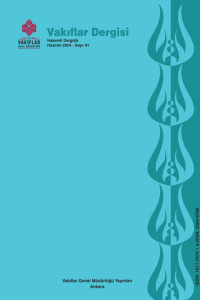Abstract
During the pre-Ottoman and Ottoman period, there was a large number of religious and cultural institutions in the province of Kastamonu, which was taken under Turkish administration at the beginning of the 13th century and witnessed a dense Turkmen settlement, and specifıcally in Araç and its surroundings. The zawiya of Abdal Pasha had direct effects on the emergence of the kaza of Araç, especially on the development of the settlement and settlement of the kaza, and the revival of its religious and spiritual life. This zawiya constituted the core of the settlement and social life activities in the district, with the district’s settlement being shaped around it. In fact, the existence of the bazaar established in the region where the zawiya is located and the shops in the vicinity belonging to the lodge foundation show that Araç’s economic vitality was realized thanks to Abdal Pasha. During the Candar period, some zoning activities, together with the Turkish settlement, draw attention to the Araç region. The most important of these reconstruction activities are the lodges, zawiyas, tombs, and their annexes. These structures were supported by the waqf institution, land and various properties were donated to each lodge, and the settlement of the Muslim population in the region was ensured, especially with the resettlement policy implemented in the Ottoman period. In addition, the most important social function of these institutions was to provide basic living needs such as shelter and food in times when transportation and communication facilities were extremely primitive. In light of archival documents, the study establishes the names and locations of the lodges, zawiyas, and tombs established in Araç and its surrounding principalities (Araç, Boyalı, Sırt, Mergüze, and Küre-i Hadid) in the Ottoman period, and their institutional functioning and activities are discussed.
Keywords
: Kastamonu Araç Abdal Pasha Ede Sultan Sheikh Musa Şehrimanlar Ahi Baba Sheikh Muslihüddin.
References
- Acar, F. (1991). Batının Doğusu Yatırım Yoksunu Kastamonu, Kastamonu. Açıksöz Gazetesi, 9 Eylül 1336/1920. Akman, E. (2008). Kastamonu Vilâyeti Sâlnâmelerine Göre Araç ve Mergüze (İhsangazi) (1869-1903), Ankara. Akman, Eyüp-Calay, Perihan, (2021). “Kastamonu İli Araç İlçesi’ndeki Adak Yerleri ve Bu Yerler İle İlgili İnanışlar”, Atatürk Üniversitesi Türk Dili ve Edebiyatı Araştırmaları/Makaleler, http://turkoloji.cu.edu.tr/pdf/kastamonu_ili.pdf, 60-75. Âşıkpaşaoğlu Tarihi, (1970). nşr. Atsız, İstanbul.
Abstract
Türk idaresine XIII. yüzyılın başında kesin olarak alınan ve yoğun bir Türkmen yerleşimine sahne olan Kastamonu ilinde Araç ve çevresinde Osmanlı öncesi ve Osmanlı döneminde çok sayıda dinî ve kültürel kurum hizmet vermiştir. Araç kazasının ortaya çıkmasında özellikle kazadaki iskân ve yerleşimin gelişmesinde, dinî ve manevi hayatın canlanmasında Abdal Paşa Zaviyesi’nin doğrudan etkileri vardır. Bu zaviye bir ölçüde kazadaki yerleşim ve sosyal hayata dair faaliyetlerin çekirdeğini teşkil etmiş, kazadaki yerleşim bu zaviyenin etrafında şekillenmiştir. Hatta zaviyenin bulunduğu bölgede kurulan pazar ile tekke vakfına ait çevredeki dükkânların varlığı kazanın ekonomik canlılığının da Abdal Paşa Zaviyesi sayesinde gerçekleştiğini göstermektedir. Araç bölgesinde Candaroğulları döneminde Türk yerleşimiyle birlikte bazı imar faaliyetleri dikkat çekmektedir. Bu imar faaliyetlerinin en önemlisi kurulan tekke, zaviye, türbe ve eklentileridir. Bu yapılar vakıf kurumuyla destelenerek, her bir tekkeye arazi ve çeşitli mülkler vakfedilerek özellikle Osmanlı döneminde uygulanan iskân ve şenlendirme politikasıyla bölgede Müslüman nüfusun yerleşimi sağlanmıştır. Ayrıca bu kurumların en önemli sosyal işlevi ulaşım ve iletişim imkânlarının son derece iptidai olduğu dönemlerde barınma ve yiyecek gibi temel yaşam ihtiyaçlarını temin etmeleriydi. Bu çalışmada arşiv belgeleri ışığında Araç ve çevresindeki (Araç, Boyalı, Sırt, Mergüze ve Küre-i Hadid) Beylikler ve Osmanlı dönemlerinde tesis edilmiş tekke, zaviye ve türbelerin isimleri ve yerleri tespit edilmiş, bunların kurumsal işleyiş ve faaliyetleri ele alınmıştı.
References
- Acar, F. (1991). Batının Doğusu Yatırım Yoksunu Kastamonu, Kastamonu. Açıksöz Gazetesi, 9 Eylül 1336/1920. Akman, E. (2008). Kastamonu Vilâyeti Sâlnâmelerine Göre Araç ve Mergüze (İhsangazi) (1869-1903), Ankara. Akman, Eyüp-Calay, Perihan, (2021). “Kastamonu İli Araç İlçesi’ndeki Adak Yerleri ve Bu Yerler İle İlgili İnanışlar”, Atatürk Üniversitesi Türk Dili ve Edebiyatı Araştırmaları/Makaleler, http://turkoloji.cu.edu.tr/pdf/kastamonu_ili.pdf, 60-75. Âşıkpaşaoğlu Tarihi, (1970). nşr. Atsız, İstanbul.
Details
| Primary Language | Turkish |
|---|---|
| Subjects | Ottoman Institutions and Civilization (Other) |
| Journal Section | Research Article |
| Authors | |
| Early Pub Date | June 30, 2024 |
| Publication Date | June 30, 2024 |
| Submission Date | September 13, 2021 |
| Acceptance Date | October 24, 2023 |
| Published in Issue | Year 2024 Issue: 61-Haziran 2024 |
Cited By
Karadeniz’de Bir Uğrak Yeri: Araç’ta Nüfus ve Yerleşim (1487-1582)
Karadeniz Sosyal Bilimler Dergisi
https://doi.org/10.38155/ksbd.1483654
The articles sent to the Journal of Waqfs with a request for publication are subject to preliminary examination by the Editorial Board and at least two academicians who are experts in their fields are sent for review. The copyright of the articles accepted to be published in the Journal of Waqfs with the referee reports and the decision of the Editorial Board is deemed to have been transferred to the General Directorate of Foundations, and a royalty fee is paid to the published articles in accordance with the relevant legislation.

